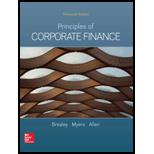
Mutually exclusive investments and project lives* As a result of improvements in product engineering, United Automation is able to sell one of its two milling machines. Both machines perform the same function but differ in age. The newer machine could be sold today for $50,000. Its operating costs are $20,000 a year, but at the end of five years, the machine will require a $20,000 overhaul (which is tax deductible). Thereafter, operating costs will be $30,000 until the machine is finally sold in year 10 for $5,000. The older machine could be sold today for $25,000. If it is kept, it will need an immediate $20,000 (tax-deductible) overhaul. Thereafter, operating costs will be $30,000 a year until the machine is finally sold in year 5 for $5,000. Both machines are fully depreciated for tax purposes. The company pays tax at 21%. Cash flows have been
To determine: The machine which is going to sell by company U and explain the assumptions.
Equivalent annual cost (EAC) is the annual cost for owning, maintain, and operating an assert for its entire life. It can be used for making capital budgeting decision and it helps to compare the cost-effectiveness of various assets that have unequal lifespans.
Explanation of Solution
The computation of NPV and EAC of option 1 is as follows:
Option 1: The selling of new machine will provide or the company will receive the post-tax cash flow from the sale of the new machine and pay the costs associated with keeping the old machine, and at the end of the 5th year company will receive the post-tax proceeds from the sale of the old machine.
Therefore, the NPV and equivalent annual cost (EAC) of option 1 is -$59,491.86 and $16,503.62 respectively.
The computation of NPV and EAC of option 2 is as follows:
Option 2: The selling of old machine will provide or the company will receive the post-tax cash flow from the sale of the old machine and pay the costs associated with keeping the new machine, and at the end of the 10th year company will receive the post-tax proceeds from the sale of the new machine.
Therefore, the NPV and equivalent annual cost (EAC) of option 2 is -$93,376.10 and $16,526.09 respectively.
Therefore, the above computation is showing that the new machine should be sold and keep the old machine since it is the least expensive option and it has the lowest EAC compared to the other one.
Assumption: The important and vital assumption is that if the machine has to be replaced, the replacement will be a machine that is compatible and efficient to operate in the manner in which the replaced machine has operated.
Want to see more full solutions like this?
Chapter 6 Solutions
Principles of Corporate Finance
- A comparative balance sheet and income statement is shown for Cruz, Incorporated. CRUZ, INCORPORATED Comparative Balance Sheets At December 31 2021 2020 Assets Cash Accounts receivable, net $ 85,600 36,800 $ 21,300 Prepaid expenses Inventory Total current assets Furniture Accumulated depreciation-Furniture Total assets Liabilities and Equity Accounts payable Wages payable 77,100 45,200 84,900 4,700 3,900 204,200 155,300 94,700 (14,700) $ 284,200 $ 13,400 8,000 (8,400) $ 257,400 $ 19,000 4,500 110,500 Income taxes payable 1,400 2,500 Total current liabilities Notes payable (long-term) Total liabilities Equity Common stock, $5 par value Retained earnings 22,800 26,000 28,900 66,400 51,700 92,400 204,000 28,500 162,300 2,700 Total liabilities and equity $ 284,200 $ 257,400 CRUZ, INCORPORATED Income Statement Sales For Year Ended December 31, 2021 $ 440,700 283,700 157,000 Cost of goods sold Gross profit Operating expenses (excluding depreciation) Depreciation expense Income before taxes…arrow_forwardHow do you calculate the intrinsic value of a stock using the dividend discount model (DDM)? Need help.arrow_forwardExplain the Modigliani-Miller theorem and its assumptions In finance?arrow_forward
- How do you calculate the intrinsic value of a stock using the dividend discount model (DDM)? i need coarrow_forwardHow do you calculate the intrinsic value of a stock using the dividend discount model (DDM)?arrow_forwardHow does the weighted average cost of capital (WACC) affect a company’s valuation? i need help in this qarrow_forward
- How does the weighted average cost of capital (WACC) affect a company’s valuation?i need correct answer.arrow_forwardHow does the weighted average cost of capital (WACC) affect a company’s valuation?i need help.arrow_forwardHow does the weighted average cost of capital (WACC) affect a company’s valuation? Need helparrow_forward
 Intermediate Financial Management (MindTap Course...FinanceISBN:9781337395083Author:Eugene F. Brigham, Phillip R. DavesPublisher:Cengage Learning
Intermediate Financial Management (MindTap Course...FinanceISBN:9781337395083Author:Eugene F. Brigham, Phillip R. DavesPublisher:Cengage Learning Fundamentals Of Financial Management, Concise Edi...FinanceISBN:9781337902571Author:Eugene F. Brigham, Joel F. HoustonPublisher:Cengage Learning
Fundamentals Of Financial Management, Concise Edi...FinanceISBN:9781337902571Author:Eugene F. Brigham, Joel F. HoustonPublisher:Cengage Learning EBK CONTEMPORARY FINANCIAL MANAGEMENTFinanceISBN:9781337514835Author:MOYERPublisher:CENGAGE LEARNING - CONSIGNMENT
EBK CONTEMPORARY FINANCIAL MANAGEMENTFinanceISBN:9781337514835Author:MOYERPublisher:CENGAGE LEARNING - CONSIGNMENT
 Financial Accounting: The Impact on Decision Make...AccountingISBN:9781305654174Author:Gary A. Porter, Curtis L. NortonPublisher:Cengage Learning
Financial Accounting: The Impact on Decision Make...AccountingISBN:9781305654174Author:Gary A. Porter, Curtis L. NortonPublisher:Cengage Learning Cornerstones of Cost Management (Cornerstones Ser...AccountingISBN:9781305970663Author:Don R. Hansen, Maryanne M. MowenPublisher:Cengage Learning
Cornerstones of Cost Management (Cornerstones Ser...AccountingISBN:9781305970663Author:Don R. Hansen, Maryanne M. MowenPublisher:Cengage Learning





